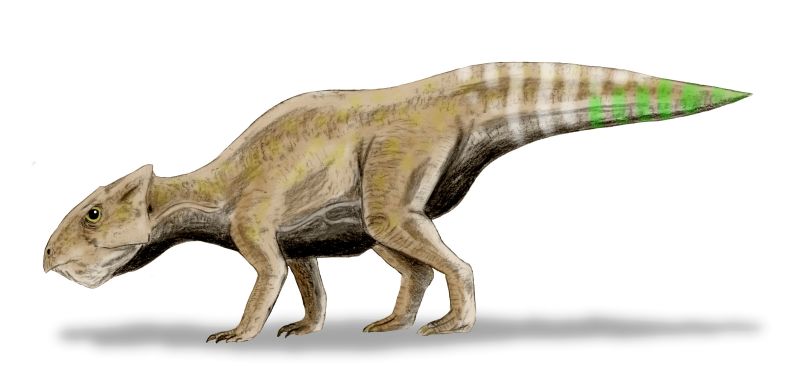Yamaceratops on:
[Wikipedia]
[Google]
[Amazon]

 ''Yamaceratops'' is a
''Yamaceratops'' is a
Dinosaur Mailing List announcement of the description (contains full abstract of the paper)
Description and Image (in German)
Ceratopsians Ornithischian genera Late Cretaceous dinosaurs of Asia Fossil taxa described in 2006 Taxa named by Mark Norell {{Ceratopsian-stub

 ''Yamaceratops'' is a
''Yamaceratops'' is a genus
Genus ( plural genera ) is a taxonomic rank used in the biological classification of living and fossil organisms as well as viruses. In the hierarchy of biological classification, genus comes above species and below family. In binomial nom ...
of primitive ceratopsian
Ceratopsia or Ceratopia ( or ; Greek: "horned faces") is a group of herbivorous, beaked dinosaurs that thrived in what are now North America, Europe, and Asia, during the Cretaceous Period, although ancestral forms lived earlier, in the Jurassic ...
that lived in Asia
Asia (, ) is one of the world's most notable geographical regions, which is either considered a continent in its own right or a subcontinent of Eurasia, which shares the continental landmass of Afro-Eurasia with Africa. Asia covers an are ...
during the Late Cretaceous
The Late Cretaceous (100.5–66 Ma) is the younger of two epochs into which the Cretaceous Period is divided in the geologic time scale. Rock strata from this epoch form the Upper Cretaceous Series. The Cretaceous is named after ''creta'', ...
period in what is now the Javkhlant Formation
The Javkhlant Formation is a geological formation in Mongolia whose strata date back to the Late Cretaceous possibly Santonian to Campanian. Ceratopsian, ornithopod and theropod remains been found in the formation. A prominent fossilized therizino ...
. Initially, the rocks where it was found in were thought to be from the Early Cretaceous, but the age was reevaluated in 2009. It was a relatively small dinosaur, reaching in length and in body mass.
The type species
In zoological nomenclature, a type species (''species typica'') is the species name with which the name of a genus or subgenus is considered to be permanently taxonomically associated, i.e., the species that contains the biological type specime ...
, ''Yamaceratops dorngobiensis'', was described by P. J. Makovicky and M. A. Norell in September, 2006. The authors consider the animal to have had an intermediate phylogenetic position between ''Liaoceratops
''Liaoceratops'', meaning "Liaoning horned face", is a ceratopsian dinosaur believed to be an early relative of the horned ceratopsids. It lived in the Early Cretaceous, 126 million years ago. It was discovered in China by a team of American and ...
'' and '' Archaeoceratops'' within Neoceratopia
Ceratopsia or Ceratopia ( or ; Greek: "horned faces") is a group of herbivorous, beaked dinosaurs that thrived in what are now North America, Europe, and Asia, during the Cretaceous Period, although ancestral forms lived earlier, in the Jurassic ...
. Examination of the frill of ''Yamaceratops'' has convinced the authors that the frill was not used for display, and that the fossils " intat a more complex evolutionary history for ceratopsian frills."
The genus name refers to Yama
Yama (Devanagari: यम) or Yamarāja (यमराज), is a deity of death, dharma, the south direction, and the underworld who predominantly features in Hindu and Buddhist religion, belonging to an early stratum of Rigvedic Hindu deities. ...
, a Tibet
Tibet (; ''Böd''; ) is a region in East Asia, covering much of the Tibetan Plateau and spanning about . It is the traditional homeland of the Tibetan people. Also resident on the plateau are some other ethnic groups such as Monpa, Taman ...
an Buddhist
Buddhism ( , ), also known as Buddha Dharma and Dharmavinaya (), is an Indian religion or philosophical tradition based on teachings attributed to the Buddha. It originated in northern India as a -movement in the 5th century BCE, and ...
deity; the species name to the Eastern Gobi
The Gobi Desert ( Chinese: 戈壁 (沙漠), Mongolian: Говь (ᠭᠣᠪᠢ)) () is a large desert or brushland region in East Asia, and is the sixth largest desert in the world.
Geography
The Gobi measures from southwest to northeast ...
. The holotype
A holotype is a single physical example (or illustration) of an organism, known to have been used when the species (or lower-ranked taxon) was formally described. It is either the single such physical example (or illustration) or one of sever ...
IGM 100/1315 consists of a partial skull; other material has been found in 2002 and 2003 and has been ascribed to the genus.
A fossilized embryo found within an ornithischian eggshell from sediments where ''Yamaceratops'' is common, was in 2008 referred to this genus. However, in 2015 it was reidentified as a bird embryo.
In 2020 Minyoung Son and colleagues reported a juvenile specimen of ''Yamaceratops'' found in 2014 at the Khugenetjavkhlant ("Khugenslavkhant") locality. This probably three years old specimen, MPC-D 100/553, was described in detail in 2022.
See also
*Timeline of ceratopsian research
This timeline of ceratopsian research is a chronological listing of events in the history of paleontology focused on the ceratopsians, a group of herbivorous marginocephalian dinosaurs that evolved parrot-like beaks, bony frills, and, later, s ...
References
External links
Dinosaur Mailing List announcement of the description (contains full abstract of the paper)
Description and Image (in German)
Ceratopsians Ornithischian genera Late Cretaceous dinosaurs of Asia Fossil taxa described in 2006 Taxa named by Mark Norell {{Ceratopsian-stub